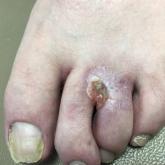Article

Nonhealing Eroded Plaque on an Interdigital Web Space of the Foot
- Author:
- Thomas Stasko, MD
- Jarad Levin, MD
- Ngoc Nguyen, MD
- Nancy Dawson, MD
- A. Neil Crowson, MD
A 53-year-old man with a history of numerous basal cell carcinomas and odontogenic keratocysts presented with a nonhealing erosion between the...
